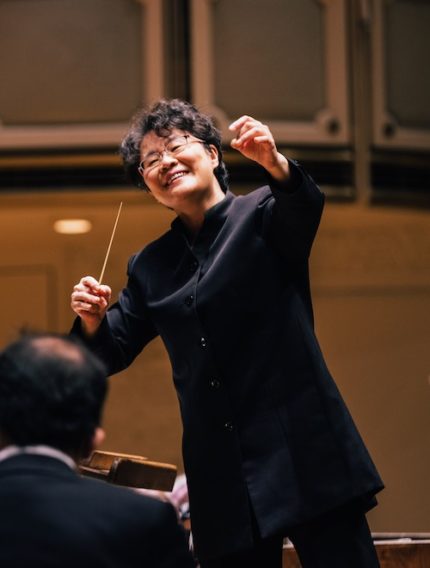Sinfonietta opens with Italian pines, a somber tribute and the joy of sax

The Chicago Sinfonietta kicked off its 35th anniversary season with a varied program that set out to achieve multiple aims. The program, titled “Next,” highlighted saxophone soloist Julian Velasco and honored late orchestra member Terrence Gray while staying true to the orchestra’s core mission of promoting artists and composers from underrepresented backgrounds alongside works from the Western canon.
The concert at Symphony Center began on Monday night with a breezy rendition of Gershwin’s Cuban Overture. Inspired by a vacation to Havana, the piece naturally featured Caribbean rhythms and Afro-Cuban percussion, maracas and all. The engaging Mei-Ann Chen radiated joy from the podium as she danced along to the main theme, while the harmonically more interesting and complex middle section raised the piece from the realm of fun party piece to something of substance. Sometimes the rhythmic shifts took a second to fall into place, yet the orchestra overall gave a nuanced performance of this exuberant piece.
Also taking inspiration from Caribbean music was Roberto Sierra’s Concerto for Saxophones and Orchestra. The Puerto Rican composer provided a fitting showcase for Julian Velasco, the first Cedille Records Emerging Artists Competition winner. Velasco, who is active in Chicago’s new music scene and a doctoral candidate at Northwestern, was the perfect choice for a piece that freely mixes jazz and classical idioms with improvised and notated music.
Beginning on the tenor saxophone, Velasco demonstrated impressive agility, dynamic control, and stylistic sensitivity in the angular first movement, while Chen kept a tight rein on the orchestra as they played complex syncopated rhythms underneath.
The second movement, aptly titled “Tender,” was almost jarringly melodic and harmonically straightforward after the first movement, presenting idyllic movie music in a slow sunlit waltz. Now playing the soprano sax, Velasco seemed most at home here, his crystalline high notes and long arching phrases showcasing his technical range. A brief return to jazzy swoops on tenor sax seemed a bit incongruous amid the more classically grounded slow movement.
The third movement was another tour de force for the soloist, requiring Velasco to switch between saxophones so quickly that he could not put the other instrument down in between. Velasco played the rapid flights with pinpoint accuracy, and the orchestra kept up admirably. Velasco also revealed a penchant for performance in the final improvised cadenza, incorporating musical jokes with a wink to the audience as he alternated between a bluesy groove and squeaky high notes, split notes, and mouth pops.

The Chicago premiere of Nigerian-American composer Nkeiru Okoye’s Voices Shouting Out opened the second half. Though written in response to the events on September 11, 2001, the short piece is not somber. The program notes read, “Okoye set out to write from her grief, yet what emerged was more of an affirmation of unity, optimism, and confidence in the face of profound challenge.”
Though the lyrical middle section was nice enough, the surrounding sections of Mission Impossible-style action film music failed to capture the profundity of the subject and did not seem particularly life-affirming. Chicago Sinfonietta gave a perfectly fine performance of this piece, though some of the solos were overpowered by the low brass and strings.
After a touching tribute from assistant principal cellist Edward Moore, the audience was given a more traditional expression of grief with a performance of “Nimrod” from Elgar’s Enigma Variations, dedicated to founding member Terrance Gray, who passed away this summer. Here, Chicago Sinfonietta’s impeccable ensemble shone through, and one could sense the players’ affection for each other in the warmth of their playing. After the final cadence, the lights dimmed, and Chen placed a bouquet of flowers on an empty chair in the violin section as members of the orchestra wiped away tears.
Closing out the program was another hallmark of the standard repertoire, Respighi’s Pines of Rome. Conducting from memory, Chen led the orchestra in an accomplished rendition of the familiar favorite. The radiant opening movement sparkled, particularly in contrast to the stately Elgar, and the rhythmic flourishes were tight as could be.
The Respighi offered numerous chances for Sinfonietta members to shine in solos. One such moment was the gentle off-stage trumpet solo in the second movement, “Pini presso una catacomba.” Similarly, clarinetist Leslie Grimm’s delicate and understated solos at the beginning and end of “I pini del Gianicolo” were a highlight of the performance. However, there were intonation and ensemble issues in the brief duet between principal cellist Ann Griffin and concertmaster Paul Zafer, as if the passage had taken them by surprise.
Though one might think the pacing of this concert a bit unusual, beginning on a lively note and ending with more introspective selections, the sonic explosion that occurred when the extra brass joined the full orchestra from the choral balcony at the end of the Respighi was thrilling and provided an exciting cap to the concert. In comparison to their final program last season, this concert let the music speak for itself and the accomplished musicians of the orchestra to shine without distraction.
Chicago Sinfonietta’s next program will be its annual tribute to Dr. Martin Luther King, January 15 and 16, 2023. chicagosinfonietta.org
Posted in Uncategorized


